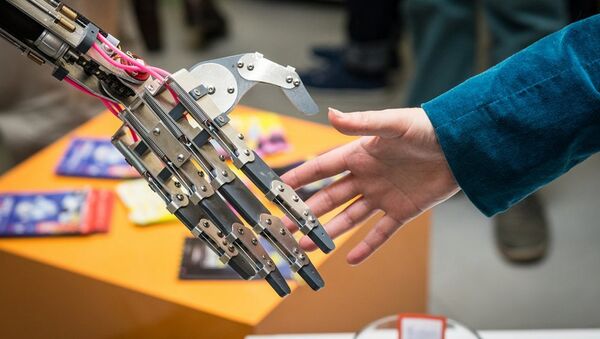Coming up November 27th at the Moscow Congress Center, Conference NIDays 2015 invites robotics experts and enthusiasts to take part in the XIV international conference of National Instruments. The conference is devoted to the technologies, industries, science and education for developing automated test systems, control and monitoring. This year’s event will feature a gathering of top industry professionals, including more than 500 business leaders, engineers, professors and researchers from all over Russia, the CIS and Baltic countries. One major focus this year will be the status and potential in the field of robotics. Key experts gather in Moscow with a broad focus, but with an emphasis on the tools that help build “next.” Here’s a short prelude before we really step into the impossible.For those unfamiliar, National Instruments (NI) and its alliance partners solve for the biggest hurdles and problems in IT and control instrumentation. During the plenary sessions and via the technical presentations at conferences like this NIDays one, the leading edge of new developments are announced, discussed, and protracted into the larger frames of industry growth. A “for example” issue experts are dealing with today, is the quest to facilitate the future growth of the high-tech industry as a whole. We spoke with Dave Wilson, Vice President of Academic Programs at National Instruments about the impact of latest developments:
“At NI, we are inspired by how our customers innovate and solve problems with our platform-based technologies. We are excited to see our engineers make an impact in Russia and around the world.”
Just one aspect, the capabilities to provide bandwidth or spectrum for wireless and IOT, is not simply a “desirability” concept from the consumer perspective. Without new systems and technologies for optimizing bandwidth capabilities, the entire industry will eventually be at a standstill. NIDays 2015, and subsequent events, showcase solutions for now, and for the future. Of course one purpose of the conference is to showcase and support NI products such as the LabVIEW Communications System Design Suite, which features a design environment and capability for very rapidly prototyping and testing capability of new communications systems development.
Also at NIDays 2015, company engineers and the aforementioned partners will present solutions, give oral and special media presentations, offer master classes, take part in round table discussions, and administer certification exams for LabVIEW. Some of the systems and sectors addressed will include; electronics and radio engineering, embedded systems automation, software and hardware tech, and automation for scientific experimentation etc. One participant in the upcoming NIDays, Robotics Center Skolkovo is slated to talk about the progress of Skolkovo startups. Attendees can probably expect to learn about Skolkovo’s partnership with National Instruments in the realm of robotics. That collaboration involves the use of the NI CompactRIO controller, and software algorithms for management and analysis of data on the graphical programming language LabVIEW. This and more with regard to the functional robot behavior are certain to be topics of discussion. With regard to the role Skolkovo plays in Russia’s innovation market, I had a nice chat last night with the Chairman of the Skolkovo Foundation, Alexei Gonnchenko, for his take on robotics progress. Here’s what he had to say:
“Robots may soon cause the same dramatic changes in our lives as cars and computers. After 10-20 years, we will not be able to imagine life without them. They will be everywhere and will make our life much more comfortable and safer. However, it is still very young and dynamic area of science and business. There are many opportunities for young and ambitious team with unconventional ideas. The fund Skolkovo helps young start-ups to overcome the typical challenges and find the funding to run a startup.”

“Today robotics technology is the embodiment our wildest imagination, a vision coming true with breakneck speed, and one that penetrates into our daily lives. At one end of the spectrum, one company I know is ready to launch a network of robotic taxis. Meanwhile, another initiative aims to replace pharmacists with robots in pharmacies. Just last year a scientist at Harvard University published a 3D biological tissue with a vascular network, one which helps to keep the cells alive once they exit the printer. Drones are becoming cheaper and more complex too. At a point a miniature quadrocopter will begin patrolling areas instead of the police, and a Wi-Fi-drone on solar energy will begin to distribute the Internet in remote areas. Robotics and technology as a whole has arrived at the future.”
Gorely went on to discuss the prospects for robotic development, potential the entrepreneur says are scheduled to “shock our conscience with their frightening potential. The “fiction” in science-fiction is certainly no longer existent in some innovation realms. Intelligent machines can already take up nearly any kind of human labor, and according to Gorely as many as 70% of business managers are prepared to use robots in their teams. The Geek Picnic creator sees no slowing down on our way to a robotics enhanced future, and Russian engineers are breaking ground into new territory every day.
Software, hardware, brilliant minds and brilliant organizations, the quest for what used to be called “space age” technologies rockets forward. The entities mentioned in this article are only representative of the vast body of work going on to achieve truly unbelievable innovation. In talking with some of these pioneers I find, the essence of what drew me to technology in the first place. The same wonder a small child exuded on watching gunfighters and cowboys act out electronic reality on a black and white TV, it is today played out for real by robotic capability akin to Star Trek, Star Wars, the starry possibility of humanity. As corny or sensational as this statement sounds, this is where we are, standing on the threshold of the impossible.


